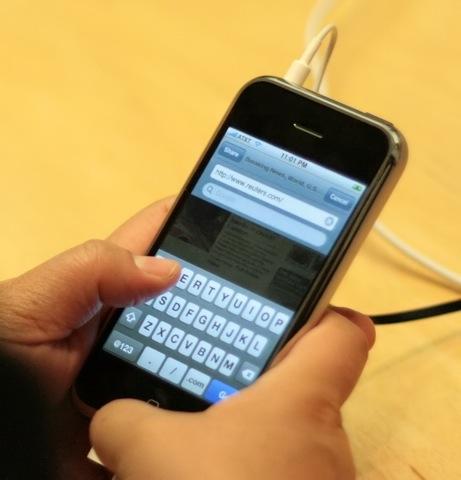Smartphones increase communication, decrease connection
An iPhone touchscreen. Smartphones like the iPhone have created new pathways for communication. (Photo courtesy of Takuya Murata via Wikimedia Commons.)
Nearly half of all Americans are now using smartphones.
That’s according to a 2012 survey from the Pew Research Center. Smartphones, mobile phones with Internet access and other advanced features like apps, allow people to connect with one another through email, social media and texting without ever having to talk. Author Daniel Sieberg thinks smartphone users feel so attached to their devices because it makes them feel like they are part of a larger social network.
“There is the innate human nature to be part of community, and to have people who want to reach out to us,” Sieberg said. “We get that immediate connection through our devices. So I think that the rise of smartphones, and the rise of nearly ubiquitous WiFi has made it harder to disconnect. We crave that interaction with people.”
One woman, Danielle, described feeling a sense of panic when her smartphone died.
“I was in a hysterical fit for about half an hour trying to figure out how to replace the phone as soon as possible. And of course it happened on a Friday night, so I had to wait the entire weekend which was going to be completely devastating,” Danielle said.
Sieberg said he’s witnessed similar reactions while on tour presenting his new book “The Digital Diet: A Four Step Plan to Break Your Tech Addiction and Regain Balance in Your Life.”
“When I talk about the book in a live audience, I often ask people to take out their smart phone and pass it to the person next to them,” Sieberg said. “You see the fear in their eyes that they have to let go of this device that has almost become an extension of themselves. This is a device that has everything from our personal emails, to our photos, our schedules. It really defines who we are in some ways.”
Smartphones generate a sense of community while eroding some of our most fundamental methods of communication. When Danielle’s smartphone broke and she had to use a replacement, she realized she was unaccustomed to using a phone to make calls.
“I don’t talk on the phone. I am starting to now, but I had forgotten the value of inflection and tone,” Danielle said.
According to Sieberg, smartphones have increased the amount of interaction we have, but have decreased the quality of that interaction.
“We have the convenience, the immediacy, and in a cynical way, the efficiency of interacting with all sorts of people all at once,” Sieberg said. “Instead of that linear path through a phone call where you do have to spend 15 to 20 minutes or more focused on one person, you can have all these relationships going on almost simultaneously. Now you have to ask yourself ‘what’s the quality of all those interactions?'”
In his book, Seiberg offers a four-step plan to help readers reduce their technology burdern.
“Rethink, reboot, reconnect, and revitalize. Those are the overarching pillars. It’s not about getting rid of anything necessarily, it’s really about what is appropriate at what time,” Seiberg said.
Seiberg thinks that communications technology is valuable, but it should be used with intent.
“My concern with all of these devices is that we spend too much time extending out beyond the immediate sphere of friends and family members so we end up tripping over our children while looking at our devices or bumping into each other and forgetting about those people who really do matter and are right near us,” Seiberg said. “That’s when it becomes a concern for me. I’m all about loving technology, just not unconditionally.”
